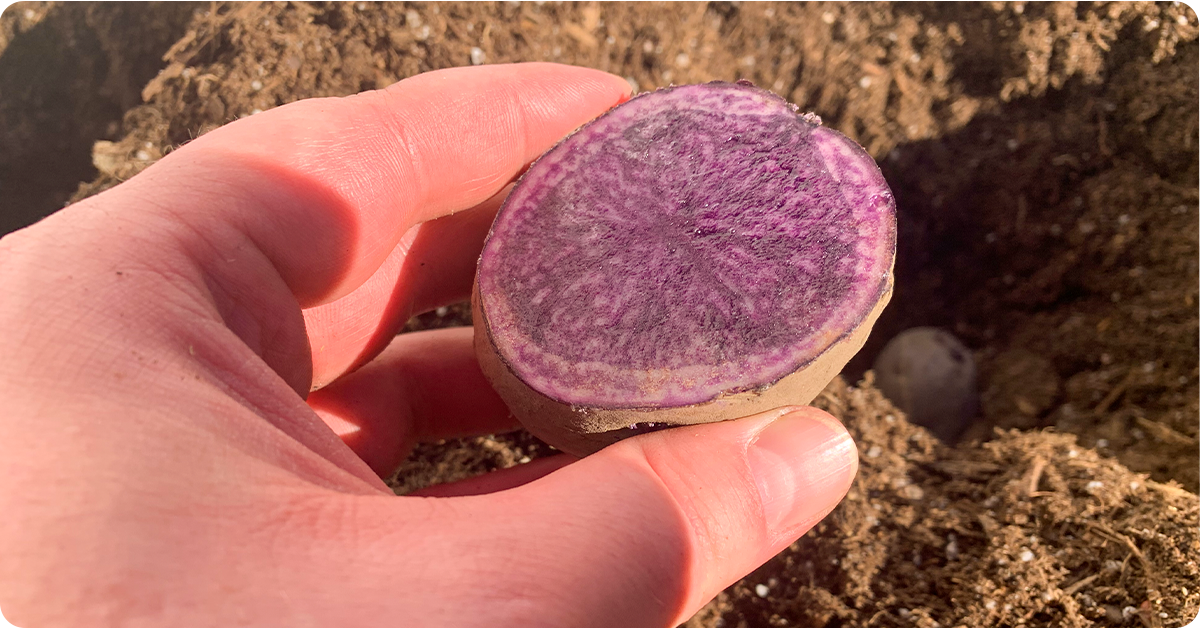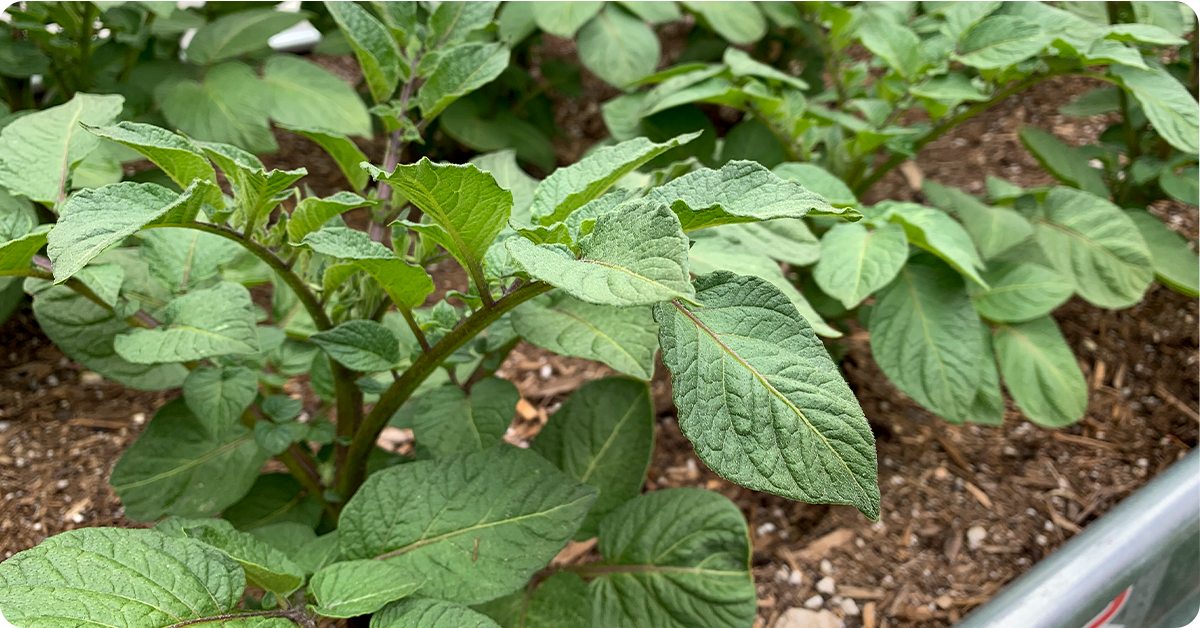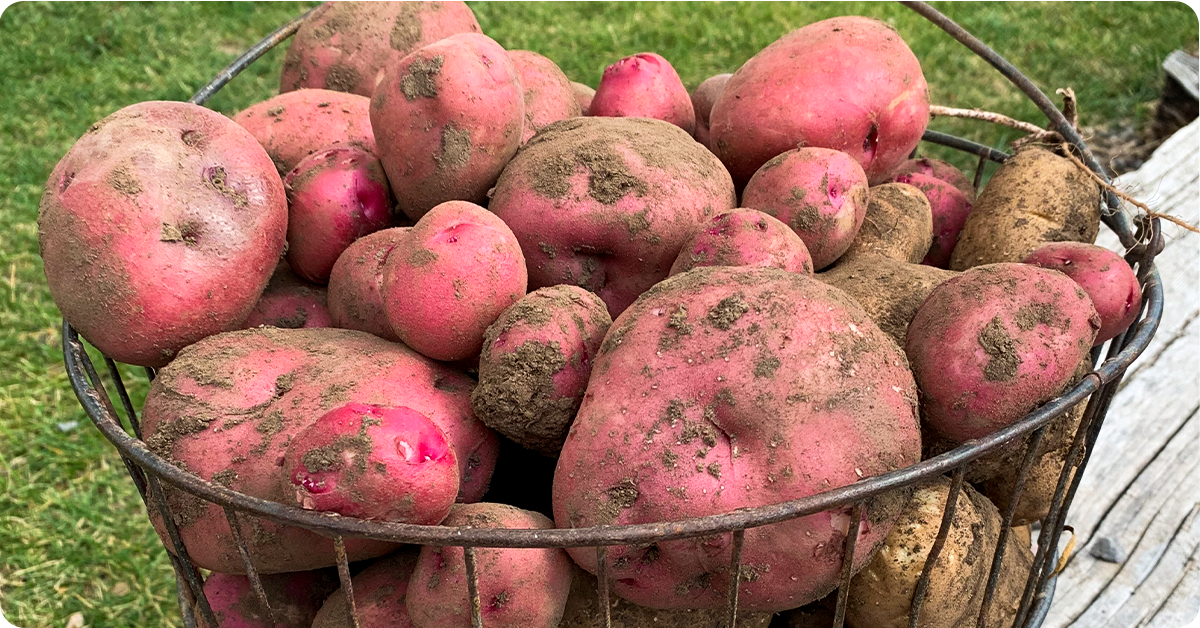
Mashed, baked or fried, potatoes are a universal favorite for breakfast, lunch and dinner. With a nearly unlimited assortment of ways to enjoy, growing the most productive potatoes is a must!
Potatoes are hardy and generally productive plants but ensuring a bountiful harvest will still require a little help from you. Choose from an assortment of classic seed potatoes or try something new. Just start preparing today and you'll be mining for and enjoying a jackpot of potatoes in no time.
Pick Your Tater Types
Store-bought potato varieties are chosen for their ability to hold-up to being harvested with heavy machinery then packed, shipped and generally man-handled before making it to your table.
Unlike potatoes sold at most grocery stores, when you grow your own potatoes you will have significantly more, and tastier, varieties to choose from. Here are a few varieties recommended by IFA’s potato-loving growers:
 |
All BlueA fun potato variety with deep blue skin and eye-catching purple flesh. These potatoes are a century-old, antioxidant rich heirloom variety perfect for many tasty uses. Best uses: steamed, mashed or freeze dried |
 |
FingerlingsOblong shape with waxy, firm flesh that ranges from buttery to earthy. Available in a number of colors and sizes, the heritage varieties are bred to be small, thin-skinned and tender. Best uses: fried, roasted or freeze dried |
 |
Purple VikingBright purple to salmon-pink skin with sweet, buttery white flesh. Some claim this pretty potato is even tastier than the popular Yukon Gold. Best uses: baked, mashed or freeze dried |
 |
Red La SodaSuper popular late red with white, waxy flesh. Most of the best and most devout potato growers who love red potatoes grow La Soda. Best uses: baked, mashed, freeze dried or potato salad |
 |
Red NorlandVery popular early red with white flesh that is usually ready to harvest by the end of June or early-July. Best uses: mashed, roasted or freeze dried |
 |
Red PontiacThin red skin with sweet, waxy white flesh. Versatile, popular red for home gardening. Great as early-harvest new potatoes and top-notch for mashing. Best uses: baked, mashed, roasted, freeze dried or potato salad |
 |
Russet BurbankDark brown skin with starchy, white flesh. These potatoes, more commonly known as “Idaho Potatoes”, are the most common variety grown in the U.S. They are a popular commercial variety found in most grocery stores. Best uses: baked, mashed, fried or freeze dried |
 |
Russet NorkotahBrown skin with starchy white flesh. These are the poster-child of potatoes that are consistent growers with an oval shape. Often grown for “fresh market” grocery retail. Great for all preparation methods. Best uses: baked, mashed, fried or freeze dried |
 |
Yukon GoldEarly-eating waxy variety with smooth, thin skin and buttery, yellow flesh. This variety is great for many uses and is especially praised by many chiefs for its texture. Best uses: baked, fried or freeze dried |
Soil Needs for Potatoes
Potatoes prefer sandy, loam-type soil; like most root crops (carrots, radishes, and onions), they do better in light, loose, well-drained soil. Garden soil prep will be important for growing the most productive potatoes. Adding organic matter and soil amendments can help if you have less productive or clay soils.
When to Plant Potatoes
Productive potatoes begin with quality seed and good planting techniques. By giving your potatoes the best start you are helping ensure a plentiful harvest.
Seed Potatoes
Choose certified seed potatoes from your local IFA or nursery for best success in planting potatoes. These varieties will be free of disease and ready for planting.
Seed potatoes can be cut up if they are large enough. Just make sure there are 2-3 eyes on each piece and let them sit overnight in a cool dry place. This allows a callus to develop over the cut that will protect the potato starts from rotting.
When to Plant
Potatoes are pretty hardy and can generally be planted as soon as you can work the ground or when soil temperatures are above 50°F. If there is a high probability for a very hard frost in your area, you might wait for a few more weeks to give your potatoes the best start.
How to Plant
Plant the pieces with the eyes up and cut side down. Plant the potato pieces 6-8 inches deep and then cover with soil.
Fertilizer
Fertilizing with a high Phosphate fertilizer at planting is essential to providing the nutrients needed for big potatoes. Phosphate does not move through the soil after planting so consider working Fertilome Tomato and Vegetable Food (7-22-8), or IFA 11-52-0 Granular Fertilizer into the soil at planting.
Potato Plant Care
Once your potatoes are in the ground, you will need to care for the plants. Though hardy, a bountiful harvest of big potatoes will require consistent care of the plants throughout the growing season.
Water
Potatoes should be watered to the bottom of the rootzone every week but be careful not to overwater! Overwatering can cause the potatoes themselves to rot, leaving you with an unusable product. Try sticking to a consistent weekly-watering routine and avoid irregular watering as this can lead to anomalies in your potatoes.
Fertilizer
Once the potato plants have grown up and out of the soil, you might consider feeding the plants with IFA Garden Fertilizer (16-16-8) or IFA Grand Champion (16-16-16). The fertilizer may be side dressed (applied to the side of the plant and watered into the roots) or lightly applied to the top of the soil with a broadcast spreader and watered in.
Mounding
Once your potato sprouts have emerged a few inches out of the ground you should mound or hill the plants by building up the soil where the potatoes were planted. This helps encourage growth and protects any potatoes growing close to the surface.
How to Harvest Potatoes
Mining for potatoes at harvest can be both fun and rewarding as you discover the culmination of your potato growing efforts.
When to Harvest Potatoes
Potatoes can be harvested and used when they are small. These would be known as “new potatoes” and are excellent when used right away, but these young potatoes will not store.
However, if your goal is a bountiful harvest of mature potatoes, you should wait until the vines have died (typically around mid-September or 90 days after planting depending on your climate). Waiting for the plants to wither is a good indication that your potatoes are full-sized and have mature skins.
How to Safely Harvest Potatoes
Insert a spading fork or shovel 18 inches away from the plant to avoid stabbing the potatoes and gently loosen up the soil. Once the soil is loosened you should be able to work the potatoes up with your hands.
Best Storage for Potatoes
Potatoes are hardy and when stored correctly can stay good for upwards of 7-8 months. You should store potatoes in gunny sacks, potato sacks, burlap bags or other containers that allow for circulation.
Step 1: Clean
Start by brushing off excess dirt before storing. You should avoid cleaning the potatoes with water to ensure they cure properly and do not start growing again.
Step 2: Cure
Curing potatoes will help them last longer by allowing the skins to harden. Potatoes can be cured by placing them in a dark space with circulating air for 7-10 days. If you do not have a cool and ventilated dark space, you can cure the potatoes while they are still in the field by allowing them to sit in the garden for 10-15 days after the vines have died.
Step 3: Store
After curing your potatoes you can move them to a more permanent storage location. Potatoes should be stored in a dark place at a cool temperature (35-45°F). Your storage area should have reasonable air circulation and high humidity for the best results. (Root cellars are a good option for achieving humidity in the intermountain west’s arid climates.)
Step 4: Monitor
You should develop a regular schedule for checking your stored potatoes for rotting or sprouting. If you can catch these problems early and throw away affected potatoes, you can prevent further contamination.
Get Growing!
With plenty of ways to enjoy your harvest, growing the best yielding potatoes is a must! Growing the most productive potato plants requires a little help and consistent care on your part but it will be worth it when you are enjoying the scrumptious rewards for months to come.
Stop by your local IFA Country store for a selection of quality seed potatoes and get started with the fertilizers and tools that you will need to grow the most productive potato plants this year.
Information for this article was provided by Brinn Hutcheon, Garden Center Asst. Manager, Riverton IFA Country Store; Nick Loveland, Assist. Manager & Certified Arborist, Ogden IFA Country Store; Herb Yost, Garden Center Manager, American Fork IFA Country Store; and Marvin Potter, Garden Center and Live Plants Category Manager, IFA Country Store














